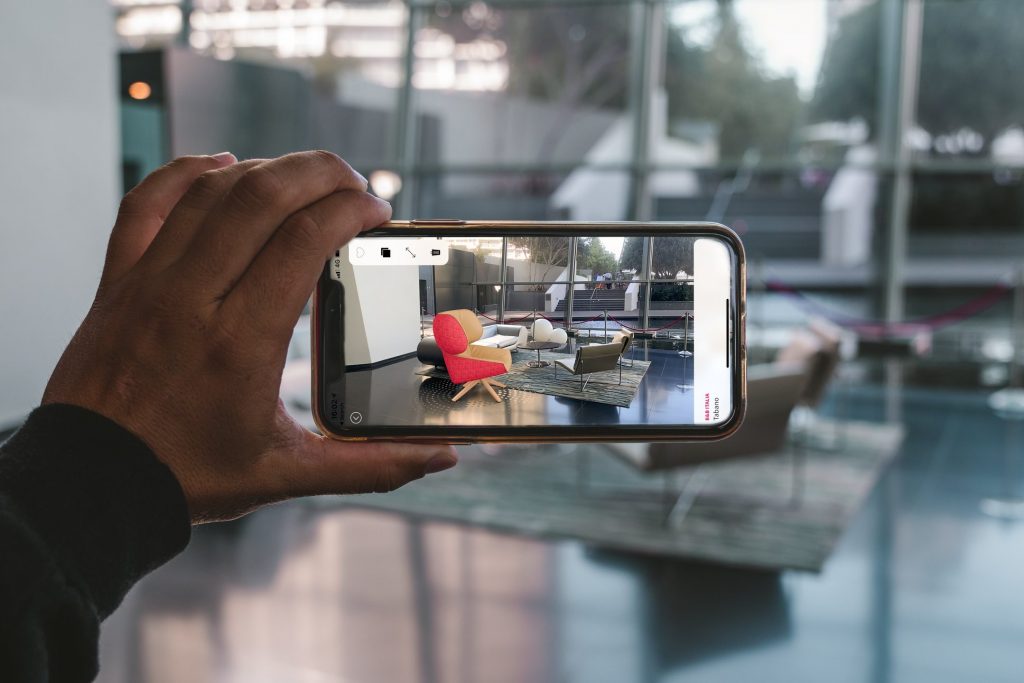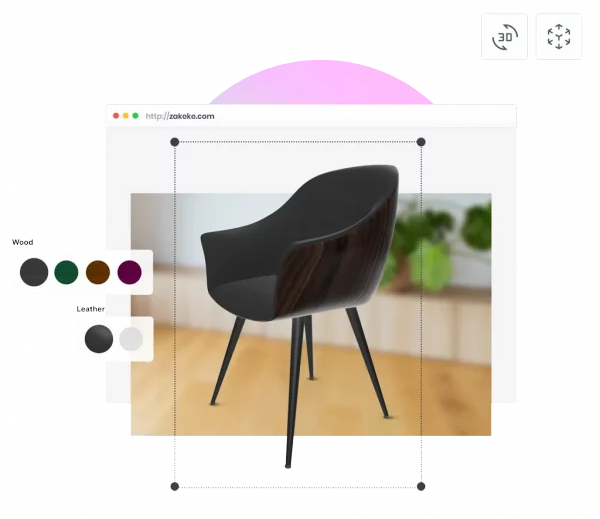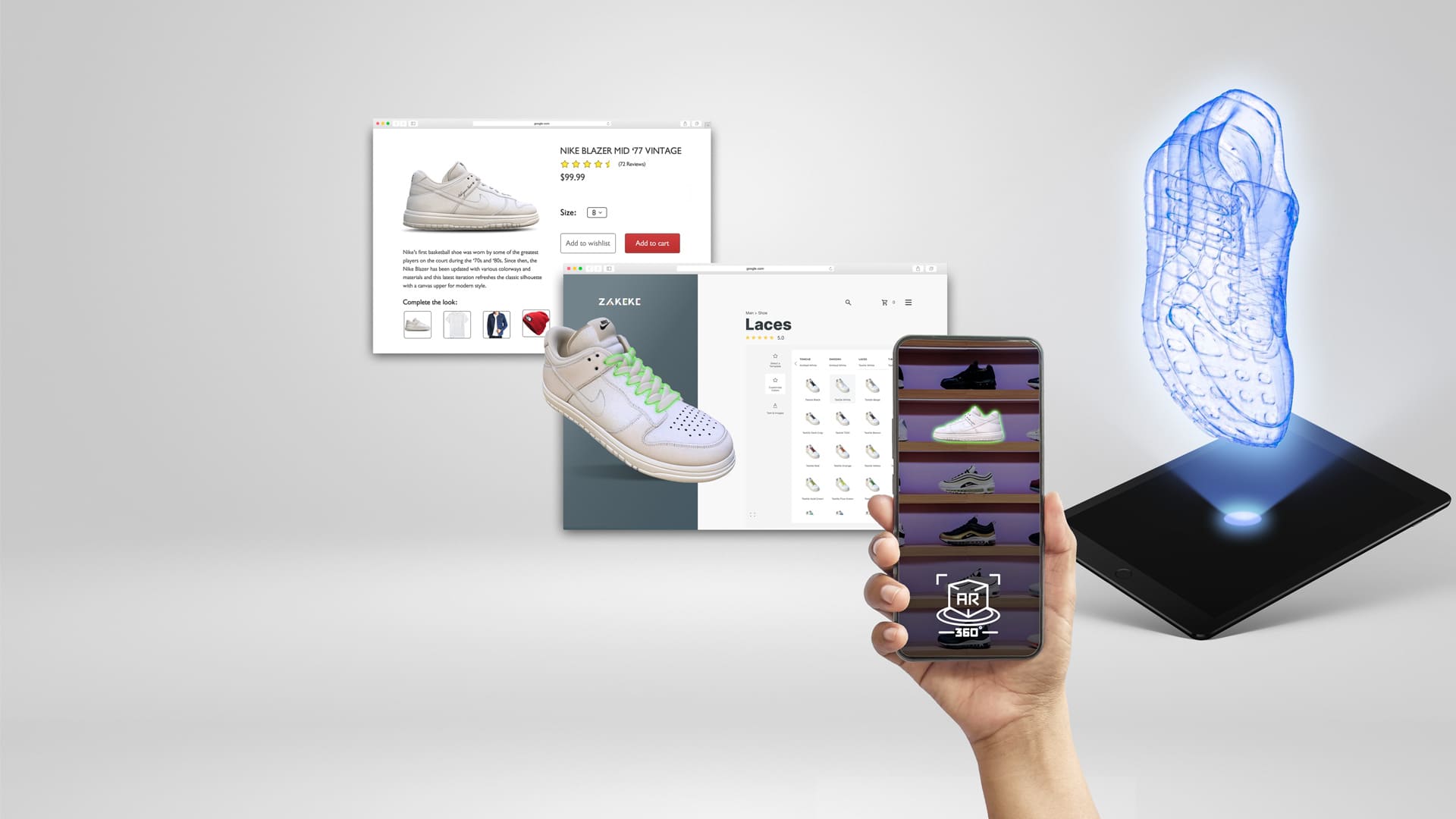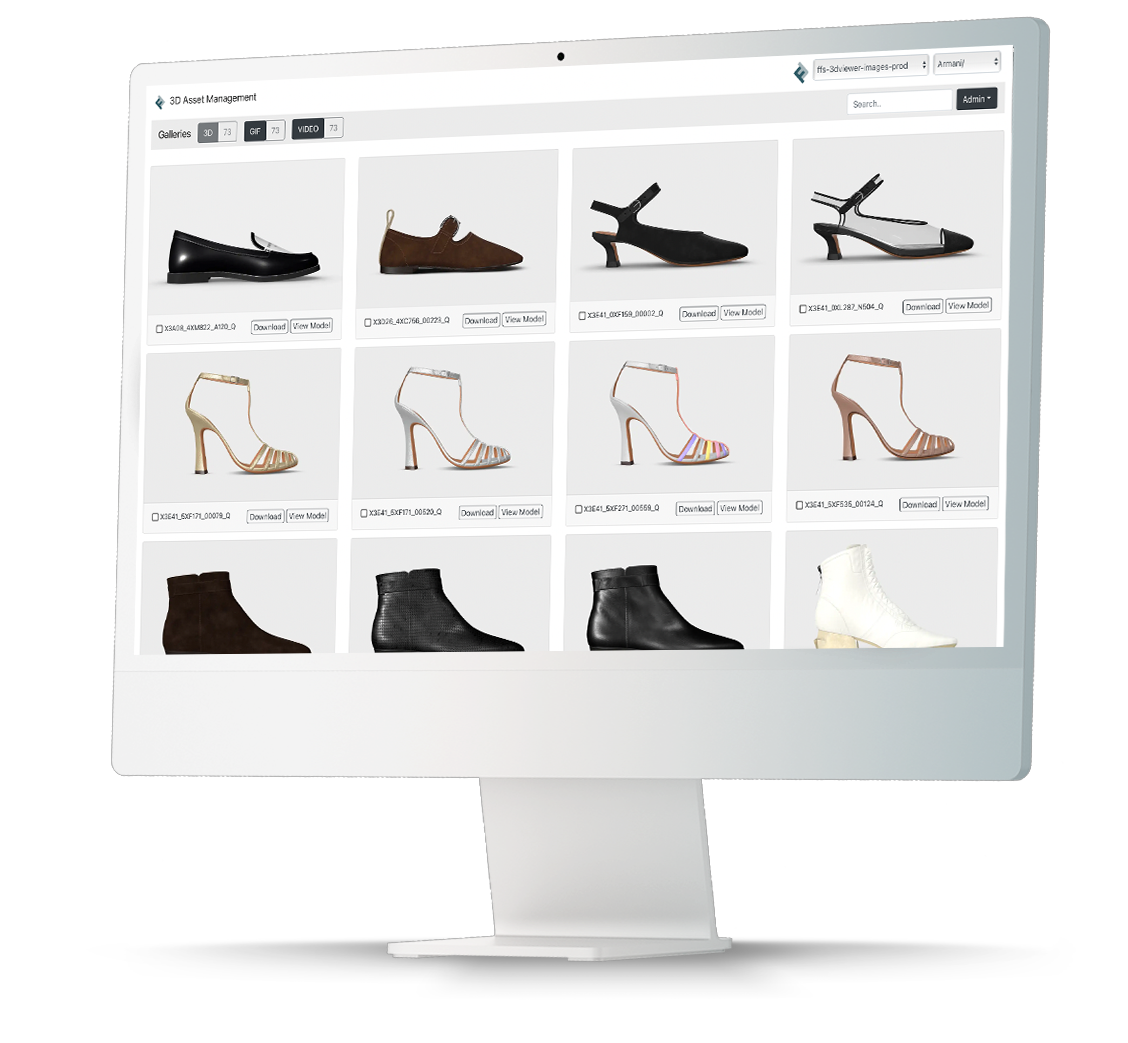Want to boost sales on your e-commerce? Need to reduce your product returns? Or perhaps gain more loyal customers and brand advocates? Start using Augmented Reality in retail and create immersive experiences!
Augmented Reality (AR) in retail has revolutionized the shopping experience. With Augmented Reality retail, customers can interact with products as they’d in a physical retail store.
The result? Increased customer engagement and interaction. 68% of customers say they would spend more time at a retailer if they could shop with AR. Brands like Nike have been using AR in their stores and are seeing a quantum leap in revenue. But not only big brands can leverage AR and see an improvement in their performances. Also, small businesses can boost their results with AR, implementing this technology at an affordable price.
But what exactly is AR technology, and how AR and VR are used today in fashion retail (and other kind of businesses)?
In this guide, we’ll explore the benefits of AR in retail and explain how it has changed the industry. We’ll also provide examples of brands extensively using AR to boost retail experience and inspiring use cases to help you implement it in your store, easily. Let’s dive in!
What is Augmented Reality?
Let’s start from the beginning. What is Augmented Reality? AR is an emerging technology that enhances the real world by superimposing digital content on real-life objects.
When someone points their camera-equipped device at an object, the built-in AR software employs a combination of computer vision and depth tracking techniques to analyze the video, recognize the object, and add digital content on top of it.
This way, AR bridges the gap between the physical and digital worlds, improving Customer Experiences and unlocking new ways for shoppers to interact with products in real-time. Think about augmented reality products: seeing a table in your real living room, try-on glasses before buying them, experimenting sports accessories from your screen… this is a real retail revolution!
AR in Retail Stores: Trends & Stats
AR has revolutionized the retail experience, ushering in radical changes that have truly redefined the future of retail. More and more brands are leveraging AR in their retail stores, and here are some stats that prove it.
- The industry is projected to grow at a CAGR of 13.72% from 2023 through 2027;
- Consumers are eager for AR. Deloitte found that 71% of e-commerce buyers – especially Gen Z and millennials – say they’d shop more often if AR technology were more readily available;
- And more: TechJury says that 70% of consumers believe AR can provide valuable benefits while shopping, and furthermore.
In other words, AR shopping is really redefining the retail market. From virtual and AR shopping and in-store displays to virtual try-on features, AR in retail is everywhere.
Just consider that retailers like Adidas, Nordstrom, Macy’s, and Ralph Lauren have already added virtual fitting rooms and AR experiences to their stores, giving consumers new shopping options while increasing sales and reducing returns.
How Brands Are Using AR and VR in Retail for Marketing & Sales
What are the most common use cases of AR in retail market and e-commerce? Here are 5 cool examples of using AR in retail:
- Virtual Try-On: AR technology allows customers to virtually try on clothes, accessories, and even makeup before making a purchase. It saves time and gives customers a clear idea of what they’re buying, boosting customer confidence and making the shopping experience more engaging;
- AR Fitting Rooms: AR technology lets customers see how clothes, glasses or hats would look on them without physically trying them on. They can see how different colors and sizes would look on them, making the shopping experience unforgettable even in-store;
- Interactive Product Visualization: AR lets customers interact with products in a more engaging way. For example, furniture retailers can use AR to give customers a 360° product views and showcase their catalog from every angle in real environments;
- Augmented Reality Store Navigation: AR Apps can guide customers through the store, helping them find products and promotions, improving the Customer Experience and reducing the time spent inside the store;
- AR Configurators: Think about allowing customers to see a sofa in their living room, or canvas on their walls. Ok, now think bigger: allowing them to configure these items while seeing them in real-time with AR. Isn’t it the ultimate shopping experience?
- Experimental Immersive Experiences: AR lets customers experiment with your products in real-time in their own spaces, making the experience more immersive and engaging. Think about using Augmented Reality for advertising and marketing campaigns: customers see your products in real-time, in their own spaces, before buying them. The result? More engagement, more customers, more sales!
- AR-Enabled Product Information: AR technology can also be used to provide customers with more information about products. For example, a customer can scan a product label with his smartphone to access detailed product information, videos, and reviews.

AR Shopping: Which Industries Are Using It the Most?
AR in retail has the potential to benefit numerous industries, but which businesses are using this technology most effectively today?
- Furniture: AR helps customers visualize how furniture items will look and fit in their own homes, enhancing the buying experience and boosting confidence even for high-ticket items;
- Fashion: AR in fashion retail allows shoppers to try on clothes virtually, offering a personalized and interactive shopping journey;
- Beauty: The beauty industry uses AR for virtual makeup try-on, making it easier for consumers to find the perfect products without physical testing;
- Electronics: AR is utilized for virtual demos and interactive product displays, helping customers make informed purchasing decisions even for high-priced tech products;
- Sports: AR enhances the shopping experience for sports equipment and apparel by allowing users to try-on products and see how gear fits and performs in a virtual setting.
Benefits of Retail Augmented Reality
AR for retail offers shoppers a completely new Customer Experience. With the help of AR, shoppers can virtually touch, move, spin and view products from all perspectives. This has resulted in many benefits for retailers, including:
1. Enhanced Shopping Experience
The most obvious benefit of using AR in e-commerce is the enhanced customer experience. Studies have shown that more than 96% of customers will leave a brand due to poor customer experience. AR ensures this doesn’t happen! By bringing products to life virtually, AR allows users to get a sense of what they’re buying without seeing or touching the product physically.
The increased user experience results from how this technology brings everything to life. Rather than viewing static images, AR allows you to virtually touch, spin, view products from all angles, and even try the product. In other words, it allows shoppers to get a better sense of what they are buying without taking a trip to the physical store.
2. Increased Engagement and Customer Satisfaction
AR in retail offers piques customers’ interest in products while providing all the additional info they might need. By interacting with products virtually and trying on new products, customers engage more with a brand and its products. In fact, Augmented Reality leads to the discovery of more products.
Additionally, Augmented Reality in retail stores ignites that emotional bond between customers and the brand. And when customers are more emotionally involved with a brand, they’re more likely to make repeat purchases, leading to customer loyalty.
3. Improved Product Visualization
One of the biggest problems shoppers face is trying to visualize a product in their lives. Whether it’s a cosmetics item or a piece of furniture, many shoppers struggle to visualize how the product will look on them or in their homes.
With AR, consumers are able to visualize a product in real life. Many furniture and home décor companies are leveraging AR to help shoppers get more conversions. With AR, consumers can test whether the furniture will fit in their space and have a better feel of how it will look in their home.
4. More Sales and Revenue
Augmented Reality improves the in-store experience, which, in turn, boosts sales.
This is because consumers who have a positive experience with a brand are more likely to make repeat purchases. Better still, the product try-on feature boosts the buyers’ confidence in the products, encouraging them to purchase.
5. Fewer Returns
Merchandise worth approximately $102 billion was returned to stores in 2020. According to Chargebacks911, 37% of returns are the result of the shopper not liking the item, while 67% are due to a mismatch in the product description.
AR in retail can help avoid these problems. With AR, customers can try on the product before buying and only commit to buying if the products virtually fit them or look great in their homes. Rather than relying on the static images displayed on Amazon, shoppers can try out the product, zoom, spin it, and even view it from all angles. This reduces the likelihood of product returns.
6. More Personalized Experience
AR can place products in customers’ real-life environments, providing a level of personalization that static experiences cannot achieve. This means shoppers can see how products fit into their own lives, whether it’s trying on virtual clothing or seeing how a piece of furniture looks in their living room. This personalized experience not only enhances customer satisfaction but also builds a stronger connection between the customer and the brand.
Companies That Use Augmented Reality: Real-World Examples
Here are some examples of brands reaping big from Augmented Reality retail shopping:
- IKEA
IKEA is a highly recognized home furnishing retailer with more than 300 stores worldwide. In 2017, the company introduced the “IKEA Place” app that allows shoppers to experience the power of AR through their phones.
The app allows consumers to virtually place pieces of furniture in their homes, so they can imagine how the furniture will look and feel in the space.
- Sephora
Sephora, a French multinational retailer of beauty products, uses AR in marketing campaigns to increase sales through its Virtual Assist app.
The app leverages 3D facial recognition technology that allows shoppers to try different makeups by scanning their faces. This app boosts shoppers’ confidence in the product by demonstrating how the products will look when applied. Shoppers can try out different products and only buy the ones that look good on them.
- ASOS
ASOS, one of the most popular fashion retailers, now employs AR technology on its website, featuring simulated models that customers can dress up. This cutting-edge technology allows shoppers to see how apparel and accessories look on different body types, providing a more realistic and immersive experience.
Wrapping Up on AR in Retail
AR technology in retail is definitely one of the most important trends of the moment! Leveraging the latest technologies on the market is crucial to gain a competitive advantage over your competitors.
And remember: AR is not only for big brands, it is also for smaller retailers and e-merchants that want to emerge by choosing the right allies. This technology can provide you with top performance with moderate investments, taking your business to new heights of engagement.
Your competitors are already on the track. What are you waiting for?
How To Start Using AR in Retail: Why Zakeke?
Advancements in technology have made it easy for brands to implement AR in their online stores. Some brands implemented it years ago, others are still on the fence.
The truth is, it’s never too late to implement this game-changing trend! At Zakeke, we offer the world’s simplest yet impactful Augmented Reality solutions for e-commerce stores of all sizes. Zakeke empowers e-commerce brands by providing their customers with Augmented Reality and Virtual Try-On solutions.

How to start using Zakeke? Zakeke is a plug-in that integrates seamlessly with all leading e-commerce platforms. Get in touch with us today for a tailored free demo to test it for your business.

















